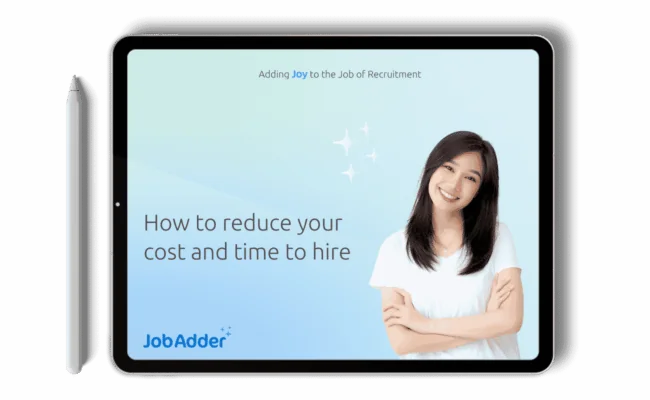Recruitment Blog
Full cycle recruiting process: How does it benefit recruiters and hiring managers?

Hiring can be daunting for most businesses. Finding the time to sift through resumes and cover letters, screen candidates and schedule interviews can be challenging.
Full life cycle recruiting, also known as end-to-end recruiting can help alleviate some stress and create a more efficient hiring process. The concept is simple: an individual hiring manager or recruiter stays on top of the hiring process from beginning to end.
FREE PLAYBOOK: 8 expert tips to increase efficiency in recruiting and hiring activity
What is full life cycle recruiting?
Full life cycle recruiting or full cycle recruiting refers to identifying, attracting and hiring top talent for a job opening from start to finish. It’s accomplished by one individual throughout the hiring process, from initial job postings to onboarding new employees. This approach ensures a recruiter can entirely focus on an individual candidate and meet the open role’s needs.
The concept behind complete life cycle recruiting is sound and can benefit a range of hiring teams. It allows for a more cohesive approach to hiring and onboarding, often leading to better quality new hires, higher employee retention rates and an improved candidate experience.
Using only one individual to recruit for an open position can be difficult for recruitment agencies. Some benefits for hiring teams don’t translate well here, and greater coordination is needed to guarantee quality candidates. However, it’s a very effective way for in-house recruiting teams to operate and can result in better hires.
Benefits of full cycle recruiting
No matter the size of an organisation, full cycle recruiting streamlines the entire hiring process. It can help a company gain valuable insights and improve its hiring performance. Here are three key benefits of full life cycle recruiting:
Improved candidate experience
Candidates are typically the most negatively impacted by a confusing recruiting process, often leading to a poor candidate experience. Additionally, disorganisation paints a poor picture of the company, its culture and its operations. It can disorient candidates and may make them feel anxious about committing to a job offer.
Potential candidates will feel more comfortable if they have a single point of contact throughout the recruiting process. It makes it easier for them to reach out with any questions or concerns about the role and ensures that they have a positive relationship with at least one team member on their first day.
A positive candidate experience during recruitment can positively impact the company culture. It sets the stage for new employees to perform at a high level and instills a sense of trust between the candidate and the hiring team. It can also increase employee retention and may guarantee better-quality candidates.
Decreased time to hire
The time-to-hire metric provides recruiting teams with helpful information on the efficiency of your recruiting process and the quality of the candidate experience. It’s one of the most critical metrics for any recruiting team and can serve as a measure of organisational health.
Having one person in charge of the entire recruiting process for an individual role can reduce unnecessary delays due to better organisation. This streamlined process means there’s less back and forth between the hiring team and the candidate, which helps shorten the timeline to find, attract and hire quality candidates.
Recruiters can also use software like an Applicant Tracking System (ATS) to help reduce hiring time throughout the recruiting life cycle. An ATS results in less tedious manual work for recruiters, allowing them to spend more time building relationships with candidates.
FREE EBOOK: How to reduce your cost and time to hire
Increased accountability on your hiring team
Accountability makes a big difference in the performance of a recruiting team. Establishing responsibility in your hiring team will result in a more cohesive and efficient process. It allows you to hold a single individual or department accountable for certain aspects of the hiring process and hold them responsible if an activity falls through the cracks. When one person is in charge of the entire hiring process, they take full accountability for the open role.
6 steps to creating a full cycle recruiting strategy
There are a few critical steps to creating a full cycle recruiting plan. These steps will ensure the project is driven by data, identifies and addresses gaps in the hiring process and can be adjusted if necessary.
Preparation
The first step in full cycle recruiting is thoroughly preparing for the job posting. This stage includes collecting data from your hiring process and researching the industry to find out what types of candidates are looking for open job roles. It also involves identifying the skills needed for a particular position to determine how to write the job post.
You should gather the necessary information from the hiring manager and other internal stakeholders to create a well-crafted job description. Ensure the job description is detailed, accurate and compelling to attract the best candidates.
The preparation step should be fast. However, the more thorough this phase is, the more likely you’ll find the right candidate for the job posting. A comprehensive preparation process gives you an exhaustive understanding of the tactics to deploy and a firmer grasp of the recruiting process.
Candidate sourcing
Use job boards, your existing database or talent pool, social media platforms like LinkedIn, and internal referral programs to find the best candidates for your open role.
Building your talent pool for a job role is incredibly important but can be time-consuming if not streamlined. Recruiters must comprehensively review resumes, ensure candidates meet all qualifications and potentially provide assessments to candidates. To speed up this process, your team can use various sourcing and screening tools, like an Applicant Tracking System.
An ATS can streamline the candidate sourcing process by empowering you to proactively source from your database and platforms like LinkedIn, while curating a talent pool of skilled candidates. It helps recruiters score candidates based on skills and qualifications and automate tasks like candidate communication.
Phone screening and video screening
Phone and video interviewing are a great way to narrow your talent pool by quickly identifying qualified candidates without the need to meet in person. It helps you get a sense of who the candidate is before scheduling an in-person interview.
Use the strategy before the face-to-face interview to ensure that candidates mesh well with your company culture and meet all requirements. This approach makes it easier to filter out low-quality candidates, saving everyone time and reducing the number of people you need to interview.
Shortlisting candidates
Once you’re confident that you have collected a qualified pool of candidates, the next step is to narrow down the list. A shortlist helps to filter out candidates with a weaker resume or those you believe will not be a good fit for the role.
While you may have an ideal candidate in mind, they may not wind up accepting your job offer. A shortlist ensures you have great options, giving you more control over the candidates you want to progress. You’ll have a clear view of the candidate pool before the face-to-face interview, making it much easier to select the best candidates for your role.
It also helps you communicate regularly with your preferred candidates, leading to more effective interviews and a more successful job offer. Regular communication leads to more recruiter-candidate rapport and a deeper understanding of whether the candidate is suitable for the open position.
Sending a job offer
The next step in the full-cycle recruitment process is to send a job offer to the best candidate from your interview pool.
A compelling job offer should include all information necessary for a candidate to make an educated decision, including salary, start date, employment benefits, company policies and more.
Including other people on your team during this step can help you properly send out a job offer and secure a new hire. They can offer a fresh perspective on the candidate, helping you identify potential red flags and determine if the candidate is the right fit for your company.
While you can bring in other people, make sure that the candidate’s point of contact remains the same. Consistency will help the candidate feel comfortable and reduce the instances of dealing with multiple people when deciding whether to accept a job offer.
Your offer should ideally have a higher salary or better benefits than the candidate’s previous position. An improved compensation package can help you stand out from your competition and boost your chances of securing a strong candidate.
If the candidate accepts the job offer, it’s time to move them into the onboarding process. However, if the candidate declines your job offer, you’ll have to return to your shortlist and offer the role to other qualified candidates.
Onboarding
The onboarding process involves a candidate’s transition into the new role within your company. It starts once the candidate has accepted their job offer and signed their contract. Onboarding is a crucial stage of the recruiting life cycle because it helps candidates understand their new job and company expectations.
Communication is crucial in the onboarding process to get them excited about their start date and keep them engaged, helping you to avoid any last-minute dropouts.
Use an onboarding checklist to help recruiters and hiring managers effectively onboard new employees into their roles. This checklist can help them communicate effectively and set the new hire up for success.
During onboarding, you can provide information about company projects and introduce your new hire to key leaders within your organisation. Schedule a one-on-one meeting with their manager and introduction sessions with their colleagues to help them get to know everyone.
You may also include relevant information from your human resources team. An employee handbook can help your new hire understand the company’s policies and procedures.
Explore how full cycle recruiting could work for you
Full cycle recruiting can help you achieve your full potential as a company in the long run. It enables you to find the right talent, conduct effective interviews and reduce employee turnover.
While this may not be the right solution for some HR teams, it’s worth exploring the benefits of full cycle recruiting and whether you could implement it within your own operations.
Ready to cut your cost and time to hire? Discover our top tips.

Related blog posts

To excel in the competition for top talent, proactive workforce planning is essential. Traditional methods struggle to adapt to evolving …
Ready to get started?
Talk to one of our friendly team members



